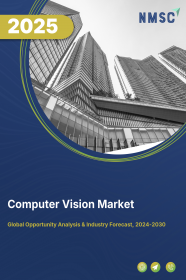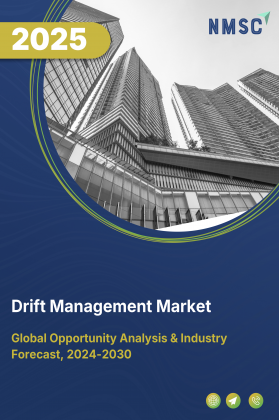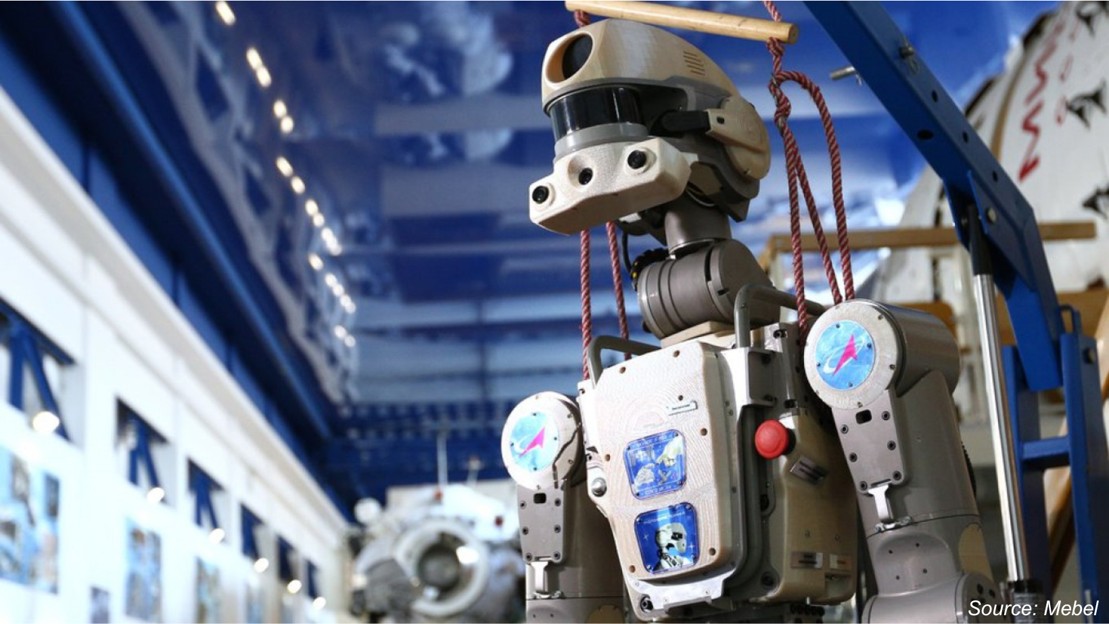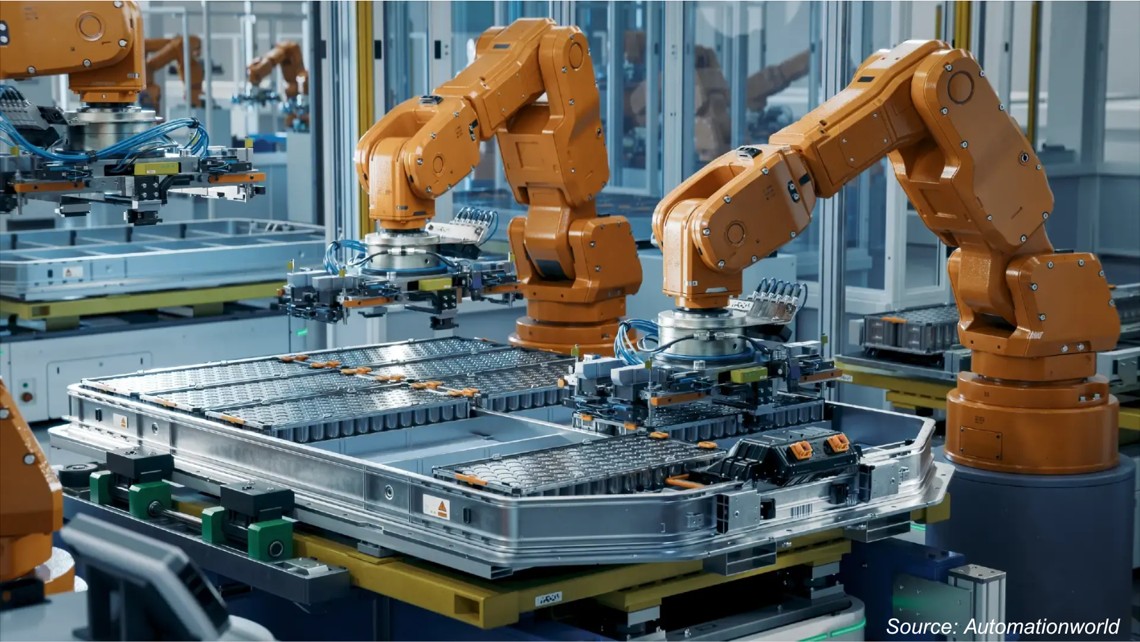
Computer Vision Market by Components (Hardware, Software, and Services), by Product (PC-Based Computer Vision Systems and Smart Cameras-Based Computer Vision Systems), by Offering (Deep Learning and Traditional Computer Vision), by Application (Quality Assurance & Inspection, Positioning & Guidance, Measurement, Identification, Predictive Maintenance, 3D Visualization & Interactive 3D Modeling), and Others- Global Opportunity Analysis and Industry Forecast 2024-2030
Market Definition:
The Computer Vision Market size was valued at USD 12.5 billion in 2023 and is predicted to reach USD 29.3 billion by 2030 with a CAGR of 15.2% from 2024-2030.
Computer vision is a specialized field within artificial intelligence that focuses on developing and applying algorithms and techniques to tackle complex real-world problems. Its primary objective is to enable computers to comprehend and interpret visual information, such as images and videos. This is achieved through the utilization of deep learning algorithms, which allow computer vision systems to learn from extensive datasets of images and videos.
Consequently, these systems can perform a variety of tasks with remarkable precision, including object detection, tracking, and recognition. Moreover, computer vision facilitates the reconstruction of 3D scenes from visual data and the integration of visual information with other sensor data, leading to the creation of more robust and accurate systems.
The applications of computer vision span across numerous domains, encompassing areas such as self-driving cars, medical imaging, robotics, augmented reality, and virtual reality. Within the medical field, computer vision aids doctors in diagnosing diseases and conducting surgeries by analyzing medical images. In robotics, it enables robots to perceive their environment and interact with objects effectively. Furthermore, computer vision plays a crucial role in augmented reality and virtual reality, where it is utilized to craft immersive experiences that blend digital content seamlessly with the physical world.
Market Dynamics and Trends
The increasing global adoption of hybrid and electric cars, driven by their environmentally friendly nature, efficiency, and reduced maintenance requirements, is fueling the advancement of computer vision technology in the automotive market. Hybrid and electric vehicles are equipped with sophisticated computer vision software and hardware to manage energy usage effectively.
According to a report by the International Energy Agency (IEA), the number of electric cars on the road reached 10 million in 2020, marking a significant 43% increase from the previous year. The report further projects that the global electric car stock is poised to reach 145 million by 2030, indicating a substantial growth trajectory for the electric vehicle market.
As the demand for hybrid and electric cars continues to rise, so does the integration of advanced computer vision systems, contributing to enhanced energy management and driving the evolution of automotive technology towards a more sustainable future.
Moreover, the increasing adoption of vision-guided robotic (VGR) systems in manufacturing industries for tasks such as quality control, assembly, fluid dispensing, and product handling is significantly contributing to the expansion of the market. Vision-guided robotic systems rely on computer vision technology to identify and locate objects, enabling them to navigate to variable target positions with precision and efficiency.
This capability allows VGR systems to execute a wide range of tasks with high accuracy, enhancing productivity and streamlining manufacturing processes. As industries seek to improve operational efficiency and maintain high standards of quality, the demand for vision-guided robotic systems continues to grow, driving innovation and advancement in the market.
Moreover, computer vision is playing a significant role in driving the agriculture sector by enabling precision farming. This technology allows farmers to gather precise data on their crops, such as plant health, growth, and yields, which can be used to optimize crop management and increase crop yields. Computer vision technology also enables farmers to monitor the fields for irrigation and fertilization needs, using drones or cameras, that can help farmers to optimize the usage of resources and reduce water wastage across countries have resulted into greater utilization of computer vision during the forecast period.
However, high deployment cost of computer vision solutions and complex integration process of computer vision systems are the factors restraining the growth of the market. On the contrary, the advancements in deep learning & artificial intelligence have greatly improved the performance and accuracy of computer vision systems. This has enabled the development of new applications, such as facial recognition & object detection in various industries, including autonomous vehicles industry, and robotics industries that is expected to create ample growth opportunities for the market in the coming years.
Market Segmentations and Scope of the Study
The computer vision market share is segmented on the basis of component, product, offering, application, end user, and region. On the basis of component, the market is divided into hardware, software, and services. On the basis of product, the market is classified into PC-based computer vision systems and smart cameras-based computer vision systems. On the basis of offering, the market is categorized into deep learning and traditional computer vision. On the basis of application, the market is bifurcated into quality assurance & inspection, positioning & guidance, measurement, identification, predictive maintenance, 3d visualization & interactive 3d modeling. On the basis of end user, the market is divided into life science, manufacturing, retail, government, defense & security, automotive, and food & packaging. Regional breakdown and analysis of each of the aforesaid segments includes regions comprising of North America, Europe, Asia-Pacific, and RoW.
Geographical Analysis
North America holds the dominant share of computer vision market and is expected to continue its dominance throughout the forecast period. This is attributed to the increasing adoption of computer vision technology in the retail industry in countries such as US and Mexico to improve the shopping experience & increase efficiency.
For instance, in January 2022, Amazon announced its plans to expand the reach of its cashierless Go convenience stores in the U.S to target work-from-home shoppers. These Go stores are equipped with computer vision technology that uses cameras to recognize and track the items that customers take from the shelves, eliminating the need for human cashiers.
Moreover, presence of key market players such as Teledyne Technologies, Allied Vision Technologies, Texas Instruments, and Intel Corporation further boost the market growth in this region. For instance, in April 2022, Teledyne launched a line scan camera called Linea ML 8k for industrial computer vision systems. It is a multispectral camera that offers versatile capabilities including spectrally independent RGB and NIR outputs. It uses Teledyne DALSA’s latest CMOS 8k quad linear sensor with a 5x5 μm pixel size and delivers a maximum line rate of 70 kHz x 4 using Camera Link HS (CLHS) fibreoptic interface.
On the other hand, Asia-Pacific is expected to show a steady rise in the computer vision market. This is due to the growing adoption of computer vision technologies in the automotive industry for efficient and accurate production processes and optimize assembly lines is further boosting the growth of the computer vision market in this region. According to the China Association of Automobile Manufacturers, China is one of the largest vehicle manufacturers in the world, witnessing a significant increase in vehicle sales of 27 million in 2022 as compared to 23 million in 2021.
Moreover, rising government initiatives and development programs for the promotion & adoption of advanced digital technologies in this region is further boosting the growth of the computer vision market. According to the latest report published by the OpenGov Asia in July 2022, the Indonesian government is investing in the development of digital technologies including AI and computer vision, aiming to become the digital hub in ASEAN region by 2024.
Competitive Landscape
The computer vision market comprises of various market players such as Baumer, Cognex Corporation, Intel Corporation, Keyence Corporation, Matterport Inc., National Instruments Corp., Omron Corporation, Sony Semiconductor Solutions Corporation, Teledyne Technologies Incorporated., Texas Instruments Incorporated, and others. These market players are adopting various strategies such as collaboration and product launches of business across various regions to maintain their dominance in the computer vision market.
For instance, in March 2023, Intel Labs launched two AI models, MiDaS version 3.1 and VI-Depth, to address the challenging task of monocular depth estimation in computer vision. These models enhance accuracy and versatility, enabling applications in robotics, augmented reality, virtual reality, scene reconstruction, mapping, and object manipulation.
For instance, in December 2021, Omron Corporation launched Vision Edition-T image processing software to its "Plug & Play" peripheral devices for collaborative robots. Through this launch, the company aims to enable improved automation solutions for inspection processes at manufacturing sites, fostering flexible collaboration between humans and machines.
Key Benefits
-
The report provides quantitative analysis and estimations of the computer vision market from 2024 to 2030, which assists in identifying the prevailing market opportunities.
-
The study comprises a deep-dive analysis of the computer vision market including the current and future trends to depict prevalent investment pockets in the market.
-
Information related to key drivers, restraints, and opportunities and their impact on the computer vision market is provided in the report.
-
Competitive analysis of the players, along with their market share is provided in the report.
-
SWOT analysis and Porters Five Forces model is elaborated in the study.
-
Value chain analysis in the market study provides a clear picture of roles of stakeholders.
Key Market Segments
By Components
-
Hardware
-
Software
-
Services
By Product
-
PC-Based Computer Vision Systems
-
Smart Cameras-Based Computer Vision Systems
By Offering
-
Deep Learning
-
Traditional Computer Vision
By Application
-
Quality Assurance & Inspection
-
Positioning & Guidance
-
Measurement
-
Identification
-
Predictive Maintenance
-
3D Visualization & Interactive 3D Modeling
By End-User
-
Life science
-
Manufacturing
-
Retail
-
Government
-
Defense & Security
-
Automotive
-
Food & Packaging
By Region
-
North America
-
U.S
-
Canada
-
Mexico
-
-
Europe
-
UK
-
Germany
-
France
-
Italy
-
Spain
-
Denmark
-
Netherlands
-
Finland
-
Sweden
-
Norway
-
Russia
-
Rest of Europe
-
-
Asia-Pacific
-
China
-
Japan
-
India
-
South Korea
-
Australia
-
Indonesia
-
Singapore
-
Taiwan
-
Thailand
-
Rest of Asia-Pacific
-
-
RoW
-
Latin America
-
Middle East
-
Africa
-
REPORT SCOPE AND SEGMENTATION:
|
Parameters |
Details |
|
Market Size in 2023 |
USD 12.5 billion |
|
Revenue Forecast in 2030 |
USD 29.3 billion |
|
Growth Rate |
CAGR of 15.2% from 2024 to 2030 |
|
Analysis Period |
2023–2030 |
|
Base Year Considered |
2023 |
|
Forecast Period |
2024–2030 |
|
Market Size Estimation |
Billion (USD) |
|
Growth Factors |
|
|
Countries Covered |
28 |
|
Companies Profiled |
10 |
|
Market Share |
Available for 10 companies |
|
Customization Scope |
Free customization (equivalent up to 80 working hours of analysts) after purchase. Addition or alteration to country, regional, and segment scope. |
|
Pricing and Purchase Options |
Avail customized purchase options to meet your exact research needs. |
KEY PLAYERS
-
Baumer
-
Cognex Corporation
-
Intel Corporation
-
Keyence Corporation
-
Matterport Inc.
-
National Instruments Corp
-
Omron Corporation
-
Sony Semiconductor Solutions Corporation
-
Teledyne Technologies Inc.
-
Texas Instruments Inc.




















 Speak to Our Analyst
Speak to Our Analyst

























